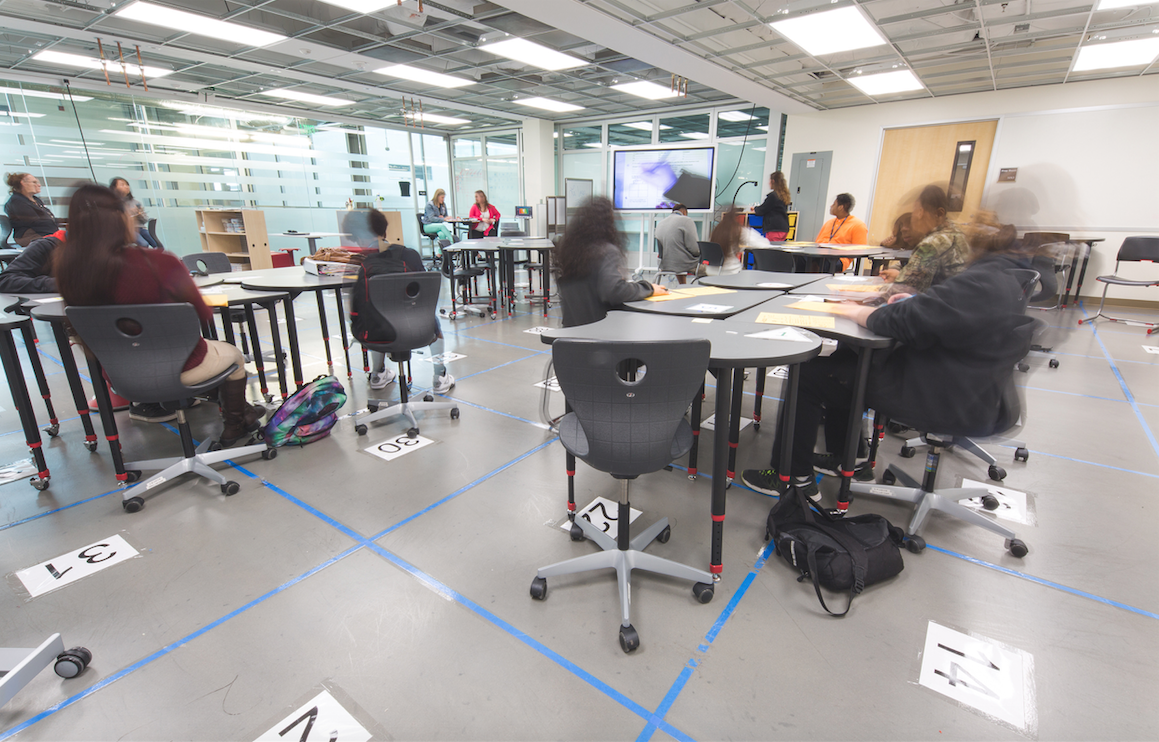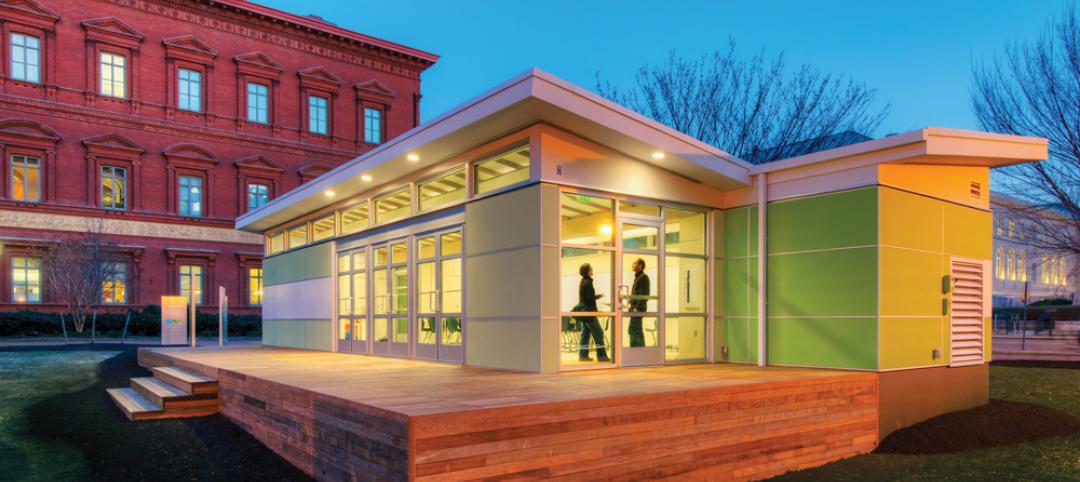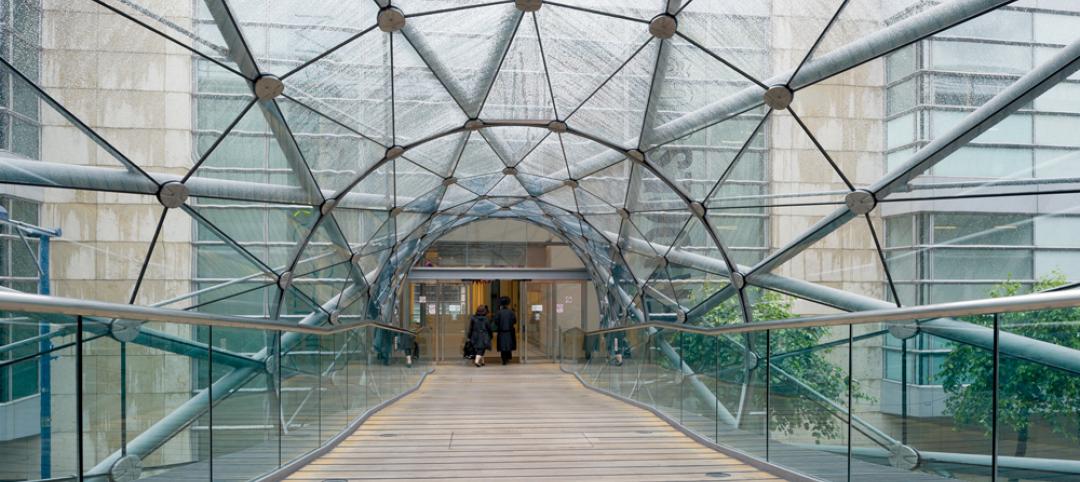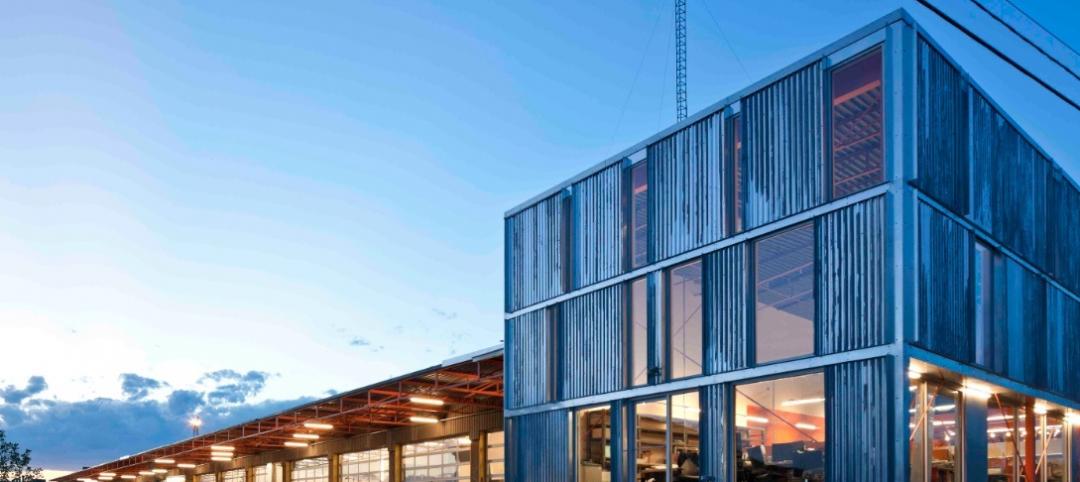At a prototype classroom on the campus of Baylor University, in Waco, Texas, school officials and teachers experiment with new types of furniture, workgroup configurations, projectors, writing boards, and mobile technology to test new teaching methods and classroom layouts.
TOP 100 K-12 SCHOOL ARCHITECTURE FIRMS
Rank, Firm, 2015 Revenue
1. DLR Group $66,300,000
2. Stantec $64,964,601
3. Huckabee $60,544,770
4. PBK $55,230,000
5. Wold Architects and Engineers $26,600,000
6. NAC Architecture $24,647,620
7. HMC Architects $24,031,965
8. Perkins+Will $19,790,000
9. LPA $19,662,221
10. Fanning/Howey Associates $18,915,132
TOP 60 K-12 SCHOOL ENGINEERING FIRMS
Rank, Firm, 2015 Revenue
1. AECOM $50,000,000
2. Jacobs $47,790,000
3. STV $10,618,628
4. KJWW/TTG $9,576,078
5. Wendel $6,321,646
6. Loring Consulting Engineers $6,000,000
7. SSOE Group $5,830,000
8. Dewberry $5,245,499
9. KCI Technologies $5,000,000
10. M/E Engineering $4,688,355
TOP 80 K-12 SCHOOL CONSTRUCTION FIRMS
Rank, Firm, 2015 Revenue
1. Gilbane Building Co. $480,004,000
2. Balfour Beatty US $461,785,038
3. Core Construction Group $421,279,721
4. Turner Construction Co. $404,115,437
5. Skanska USA $214,070,248
6. Kraus-Anderson $203,000,000
7. Shawmut Design and Construction $191,000,000
8. Barton Malow Co. $181,481,875
9. Adolfson & Peterson Construction $168,810,000
10. JE Dunn Construction $157,937,145
K-12 GIANTS SPONSORED BY:
Opened in 2015, the Learning Experience Laboratories (LEx Labs), created by design firm Huckabee, a local educational service center, and Baylor, is a microcosm reflecting nationwide trends.
The lab is a kind of flight simulator where educators experiment in ways that address forces in the corporate world and trends in technology influencing K-12 education. New styles of working—more collaborative and project-based—and mobile technology are changing how people work. The K-12 education sector is responding to those trends.
The need to revamp schools to keep up with the times adds urgency to planning and funding decisions. K-12 construction put in place declined to $12.9 billion in 2015, from $14 billion in 2014, according to School Planning & Management, so school districts have had to upgrade their physical plants with fewer resources.
Educators visiting LEx Labs frequently want to try out new concepts in furniture. Later, they discover that the space promotes the reevaluation of teaching methods. “There’s been a growing trend where the built environment has been influencing professional development,” says Kerri Ranney, AIA, Huckabee’s Director of Learning and Strategic Development. “We now are at a tipping point.”
She admits there is great variability in how quickly schools are changing. “Some clients are willing to jump far ahead in changing the pedagogy and learning environment,” Ranney says. “Others just move a couple of ticks.”
The impact on design of mobile computing devices, movable furniture, team teaching styles, and more collaborative project work means most architects are creating classrooms far different from the ones in which they were educated. When a radical concept arises it helps to visualize what the alternatives could be in a mock environment like LEx Labs.
Design firms must also help educate parents and taxpayers about new learning spaces. Building support for new projects is more important than ever, says Roger Smith, AIA, LEED AP, Principal, BBS Architects & Engineers. “Parents know a lot about their kids’ education. Their expectations are bigger, and they’re more involved,” Smith says.
To generate funding support for major new projects, school districts often mix in amenities that can be used by the whole community. These features include old standbys such as athletic fields, gymnasiums, and auditoriums, but with new twists. KSS Architects designed a combination facility that is best described as an auditorium with a gym built into it for Gottesman RTW Academy, a private school in northern New Jersey.
“They wanted the space to look like an auditorium, not like a gym,” says Merilee Meacock, AIA, LEED AP, Partner, KSS Architects. “A higher-end aesthetic was important. They wanted to display their identity such that performance was a higher priority than athletics.” An accent wall/proscenium/cloud ceiling creates a room-within-a-room effect. Resilient and durable materials ensured that the space would hold up to gym use.
The Jewish day school uses the space for high-holiday services, so the room had to look the part. This adaption helped generate financial support for the newly constructed school.
KSS’s design also had a strong narrative based on a Hebrew phrase meaning “heal the earth” to relate to stakeholders. The building was integrated within the natural contours of the hilly, wooded site. Retaining walls were built with rock blasted from the site during construction.
A garden and greenhouse provide for site-grown food. Students help tend to the gardens and sometimes help cook what they’ve grown. “They can see the life cycle of growing and cooking food,” Meacock says. Composting bins and rain barrels boost the environmental credibility.
The ecological angle was “a narrative people could visualize and understand,” Meacock says.
MAKING SPACES WORK TWICE AS HARD
Space flexibility is critical to classroom design. Spaces have to be adaptable, even allowing for drastic changes such as, say, a doubling of classroom size. Meacock recommends that walls separating classrooms should not be load bearing. Shared spaces must also be able to accommodate multiple uses. The tables in the dining hall at the Gottesman school can be removed so that the space can be used for science lab projects.
More than ever, designers must consider the furnishings during the earliest stages of a project. “If every kid has a tablet, where will we put the tablet cart?” asks Kevin J. Walsh, AIA, LEED AP, BBS’s Lead Designer. Spaces that allow for multiple furnishing configurations will be most adaptable.
K-12 design and construction firm leaders know they must keep close tabs on trends in primary and secondary education during this time of great flux. Who can predict with 100% accuracy how new generations of technology will influence teaching and learning? Where there is uncertainty over pedagogy, there must be a proportional amount of flexibility built into the design. Firms that connect best with educators tapped into influential trends will have a distinct advantage in this market.
RETURN TO THE GIANTS 300 LANDING PAGE
Related Stories
| Sep 3, 2013
Jon Pettit (1952-2013) - DLR Group Managing Principal
Jonathan (Jon) E. Pettit, AIA, died August 19, 2013 in Seattle following treatment for cancer. He was 61. Pettit was a DLR Group managing principal and practiced for his entire professional career with DLR Group.
| Aug 30, 2013
Modular classrooms gaining strength with school boards
With budget, space needs, and speed-to-market pressures bearing down on school districts, modular classroom assemblies are often a go-to solution.
| Aug 30, 2013
Local Government Report [2013 Giants 300 Report]
Building Design+Construction's rankings of the nation's largest local government design and construction firms, as reported in the 2013 Giants 300 Report.
| Aug 30, 2013
A new approach to post-occupancy evaluations
As a growing number of healthcare institutions become more customer-focused, post-occupancy evaluations (POE) are playing a bigger role in new construction and renovation projects. Advocate Health Care is among the healthcare organizations to institute a detailed post-occupancy assessment process for its projects.
| Aug 29, 2013
First look: K-State's Bill Snyder Family Stadium expansion
The West Side Stadium Expansion Project at Kansas State's Bill Snyder Family Stadium is the largest project in K-State Athletics history.
| Aug 27, 2013
Industrial Sector Report [2013 Giants 300 Report]
Building Design+Construction's rankings of the nation's largest industrial sector design and construction firms, as reported in the 2013 Giants 300 Report.
| Aug 26, 2013
What you missed last week: Architecture billings up again; record year for hotel renovations; nation's most expensive real estate markets
BD+C's roundup of the top construction market news for the week of August 18 includes the latest architecture billings index from AIA and a BOMA study on the nation's most and least expensive commercial real estate markets.
| Aug 26, 2013
Chicago Bears kick off season at renovated Halas Hall
An upgraded locker room, expanded weight room, and updated dining room with an outdoor patio greeted the Chicago Bears when they arrived at Halas Hall for practice this month. The improvements are part of a major expansion and renovation of the Bears’ headquarters in Lake Forest, Ill., completed by Mortenson Construction in less than seven months.
| Aug 22, 2013
Energy-efficient glazing technology [AIA Course]
This course discuses the latest technological advances in glazing, which make possible ever more efficient enclosures with ever greater glazed area.
| Aug 22, 2013
Warehouse remake: Conversion project turns derelict freight terminal into modern office space [slideshow]
The goal of the Freight development is to attract businesses to an abandoned industrial zone north of downtown Denver.


















